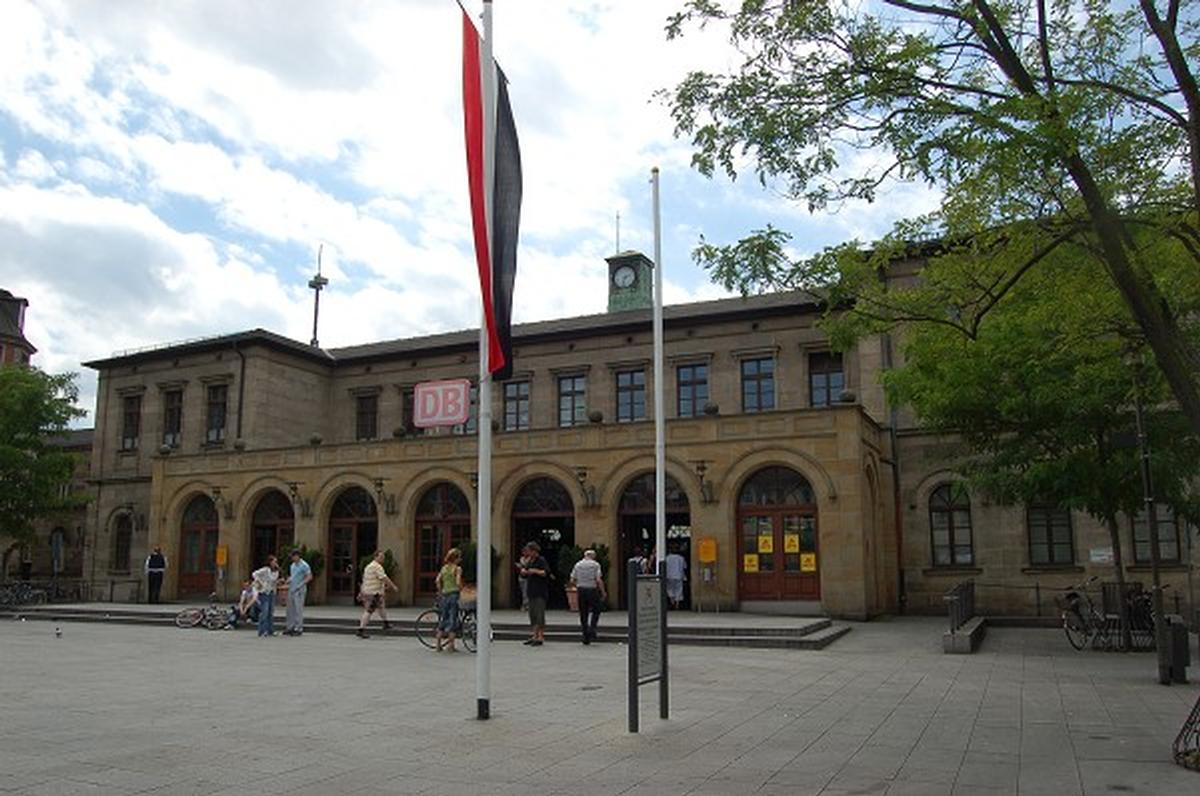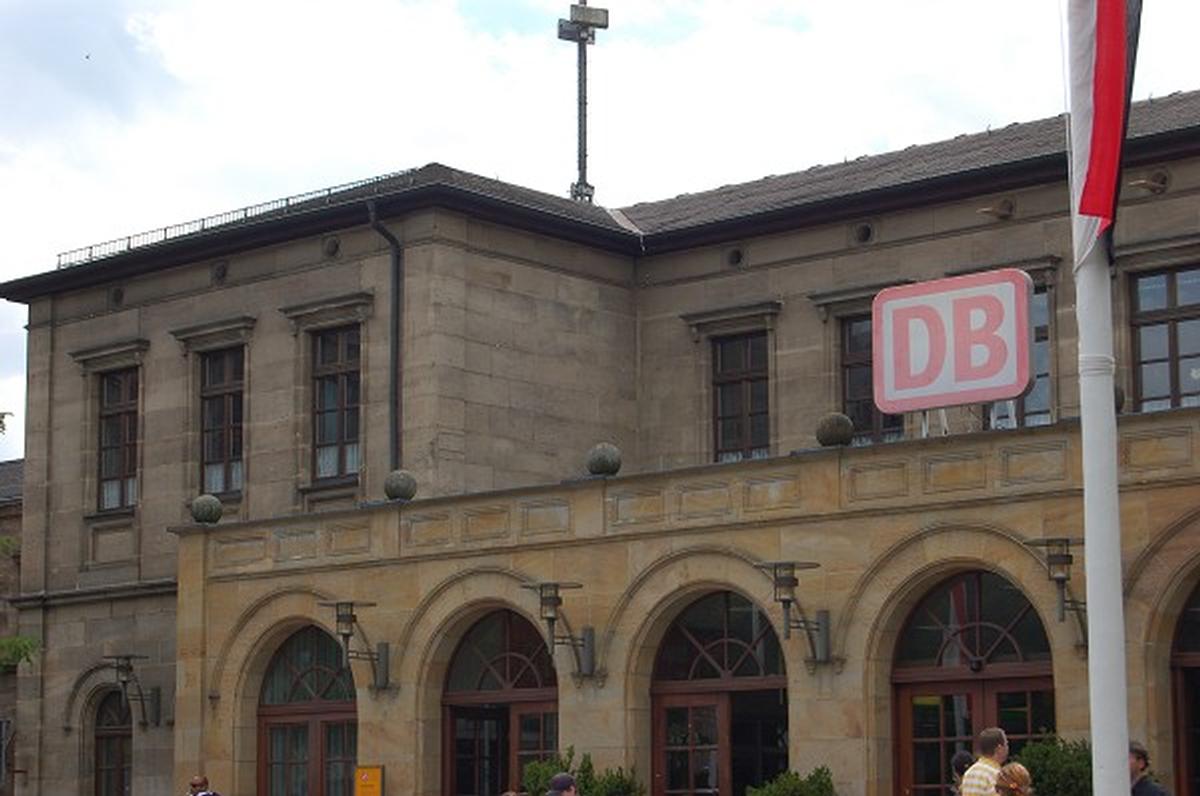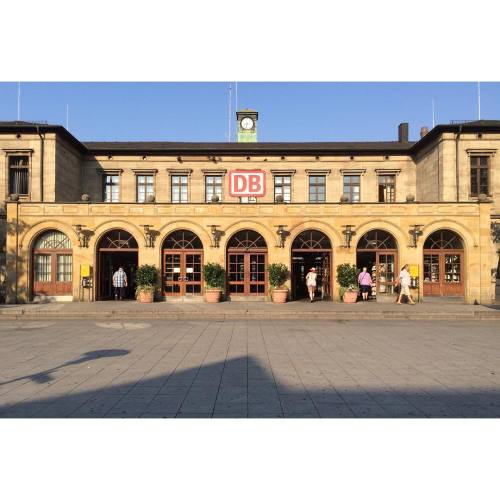Erlangen station
- Nuremberg -Bamberg ( KBS 820, 891.2 )
- Erlangen- Graefenberg ( decommissioned)
I7i12i13i15i15i16i18i20
The Erlangen Train ( according to the operating Jobs Directory: NER) is located at kilometer 23.5 on the railway line between Nuremberg and Bamberg. He is the oldest station in the city of Erlangen, and whose only long-distance support and is supported by the Deutsche Bahn ( DB AG) out in the train station category 3 (regional nodes, Highway Maintenance ). His administration is up to the management station in Nuremberg.
Location
The station is located on the western edge of Erlangen's Old Town and extends in a north-south orientation of the overpass " On the Old Town Cemetery " to the overpass over the Güterhallenstraße.
Infrastructure
The station has four through tracks, of which the tracks are for passing long-distance and regional trains and the tracks 2 (non-regular ) and 3 1 and 4 used for launching and ending in Erlangen regional trains. Other features of each platform include digital destination displays and weather- protected seating. All platforms are connected via a pedestrian underpass with each other as well as the station forecourt to the east and the bus station west of the railway property as disconnected. The eastern entrance is established via escalators through the reception building and a ramp accessible from the western city wall street, the west access from the bus station takes place at the same level.
The main platform ( platform 1) is 421 m long and 76 cm high, covered in the area of the reception building and reached via ramps and fixed stairs from street level from. The tracks 2 and 3 have a common 287 m long and 26 cm high, partly covered central platform, which is joined via fixed stairs from both sides of the pedestrian tunnel. This platform is fully refurbished since 2012. Track 4 has a 383 m long and 76 cm high, partly covered side platform, which is connected to the pedestrian underpass from both sides via fixed stairs. Barrier-free access to platform 4, there are ramps from the pedestrian underpass to the northern end of the platform and of the Friedrich- List-Strasse to the southern end of the platform.
In the reception building, a temporarily busy ticket office and a waiting room for travelers. Furthermore, there is a train station bookstore, catering and sanitary facilities. There are 1262 bicycle parking spaces that are partially covered, on the west side also 2136 Park - and-ride parking spaces for cars on both sides of the station.
The closest
( - Berlin - Leipzig - Erlangen - Nuremberg - Augsburg / Ingolstadt - Hamburg Munich ) in long-distance traffic of the railway station from the line 28 is operated in a two -hour intervals, as locomotives are doing the ICE multiple units of class 411 (ICE T) for deployment. And 891.2 (Nürnberg - Fürth - Erlangen - Forchheim ) in the transport of the station as part of the course book sections 820 ( - Fürth - Erlangen - Forchheim - Bamberg - - Lichtenfels Sonnenberg Nuremberg) is served by regional express trains. The RE- trains from Talent 2 - drive vehicles driving on schedule at 160 km / hr. Within the regional transport system Nürnberg ( VGN ), these services are referred to as regional train line R2. Since December 2010, also runs the S -Bahn line S1 at the Erlangen Train.
To the east of the station is the main station stop, formerly Station Square, next to the city bus lines 281, 283-289 and 293-295 of the CBI and the lines 20, 30, 30E, VAG and regional bus lines 202, 203, 205, 253 of the OVF hold. The west of the station stop can bus station is served by regional bus lines 201, 208-210 and 254 of the OVF.
Architecture
The today is a listed station building was built according to plans by Eduard Rüber than one storey Sandsteinquaderbau. It consisted of an open Mittelbau to be joined in the north and in the south ever a waiting room for passengers. Between 1868-1870, the first conversion was followed by Friedrich Bürklein, in which the entire building increased and the porch was converted to an open loggia with Neurenaissanceelementen. 1919 designed a loggia to an enclosed porch to that was in the 1950s, replaced by a modern waiting room. During the last renovation 1991, the state before the post-war time modernization was visually restored.
History
The station was opened together with the Ludwig South - North Railway section Nuremberg -Bamberg already on August 25, 1844, the birthday of King Ludwig I, of the Bavarian State Railways. However, the regular operation on the route could be taken after completion of all construction works only on 1 September 1844 the passenger service was followed a month later on October 1, 1844. To railway station he was with the opening of the secondary path Erlangen- Graefenberg ( " Secu " ) on 17 November 1886. trains of the secondary path generally concluded in a track south of the reception building. Due to the increasing volume of traffic, the single-track line was no longer grown, was the two-pronged scale from the start line towards Bamberg 1891 and 1892 passed from Fürth coming traffic. On 1 October 1894 outbound from Nuremberg Central suburban traffic was set up, which had one of its endpoints in Erlangen. The station was also the terminus of the passenger trains on the route of Erlangen- Herzogenaurach until the passenger on September 28, 1984 were adjusted. Further expansion saw the train station with the inclusion of the electric train service on May 15, 1939. After the Second World War and the division of Germany, the date on the railway line between Nuremberg and Bamberg running traffic shifted to the north on the route via Würzburg and coupled to the train station thus from the long-distance transport. His function as a hub went with the closure of the " Secu " lost on 17 February 1963. In the late 1960s, an improved local transport service with dense clocks was in the Nuremberg, as a precursor to a possible S-Bahn system, introduced on the main lines, in the Erlangen was also integrated. The plans were concretised in the 1980s and Erlangen set a target for the second stage of the Nuremberg S- Bahn network, but initially followed by integration into the VGN founded on 27 September 1987. After the fall of the Berlin Wall and the reunification of the long-distance range has been substantially extended to Berlin.
Planning
In connection with the high-speed line Nuremberg -Erfurt or the S -Bahn to Forchheim adjustments to the track plan and the infrastructure of the station are provided. The two outer tracks (1 and 4 ) are approached in the future of long-distance and fast regional services, the two middle tracks (2 and 3 ) are the S -Bahn reserved, for which the existing platform to S -Bahn - level (140 m long and 76 cm high) is placed. The double track connection between track 2 and 3 at the southern end of the platform is removed and replaced north of the station by platform changes between all tracks. Between the bridge over the Martin Bühler road and the bridge over the Schwabach a turning track for the years ending in Erlangen S-Bahn courses will be built.
Following the expansion of the platform 1 is modified so that trains can pass through the station at a speed of 160 km / hr.










